Reconviction rates in Scotland: 2014-2015 offender cohort
Analysis of trends in reconviction statistics up to the latest cohort of 2014 to 2015.
This document is part of a collection
1. Main findings: reconviction rates for court disposals
This section provides statistics on reconviction rates for offenders convicted in court in 2014-15, which includes only those offenders whose index conviction was dealt with in court.
1.1 Headline figures
( Table 1)
There were 43,634 offenders discharged from custody or given a non-custodial sentence in 2014-15, a number which had been declining every year from 53,309 in 2006-07 to 41,705 in 2012-13, but has increased by 4.6% (1,929 offenders) since 2012-13.
The reconviction rate and average number of reconvictions per offender ( Table 1 and Chart 1) have generally been declining over the past decade. There was a slight increase in both the reconviction rate and average number of reconvictions per offender in 2008-09 which is likely to be due to Summary Justice Reform, which was designed to take less serious cases out of the justice system at an earlier stage, and to improve the efficiency of court processes, which resulted in cases being processed faster through the courts. Between 2005-06 and 2014-15, the reconviction rate has fallen by 4.3 percentage points from 32.5% to 28.2%, and the average number of reconvictions per offender has fallen by 16.7% from 0.60 to 0.50. These reductions are set against the context of a 41% drop in recorded crime since 2006-7 ( Recorded Crime in Scotland). Crime and victimisation surveys also reveal a similar pattern of falling incidence of crime ( Scottish Crime and Justice Survey).
1.2 Age and gender
( Table 2, Table 3, Table 4 and Table 5)
Headlines for gender
Continuing a persistent long-term trend, males have higher reconviction rates and a higher average number of reconvictions per offender than females ( Table 2 and chart 3 and 4). The average number of reconvictions per offender for the 2014-15 cohort was 0.51 for males, and 0.44 for females which represents a 3.8% decrease for males and no change for females since 2013-14. The reconviction rates were 29.2% for males and 23.4% for females, representing a 0.4 percentage point decrease for males and a 0.1 percentage point increase for females since 2013-14.
Chart 3: Average number of reconvictions per offender males and females, 2014-15 offender cohort
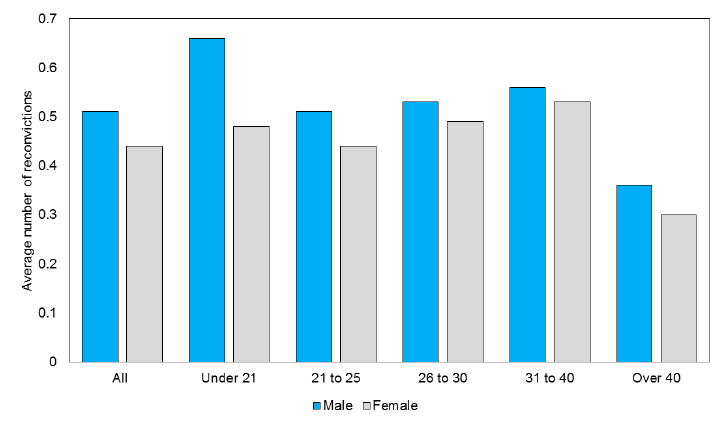
Chart 4: Reconviction rate for males and females, 2014-15 cohort
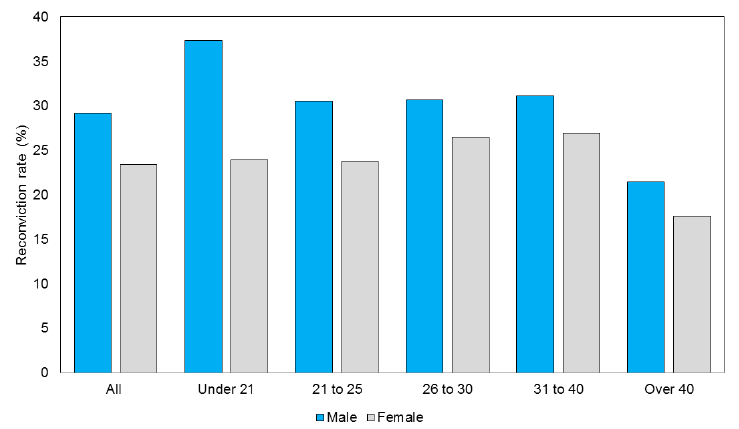
Aged under 21
Offenders under the age of 21 had the highest reconviction rate of all the age groups (35.3%) in 2014-15, an increase of 1 percentage point from the previous cohort. They also had the highest average number of reconvictions per offender (0.64). This was 14% higher than for the age group with the second highest average number of reconvictions per offender, which was the 31 to 40 age category at 0.56 ( Table 3).
Over the longer term, the average number of reconvictions per offender under 21 has decreased, by 31% from its highest level of 0.93 in 1997-98 to 0.64 in 2014-15. And while reconvictions for offenders aged under 21 were previously considerably higher than for the other age groups, their current levels are now comparable.
More recently however, the reconviction rate for the under 21 age group has increased for the second time in a row, rising by nearly 2 percentage points from 33.4% in 2012-13 to 35.3% in 2014-15. Despite the recent increase the current value is still 7.1 percentage points lower than the 1997-98 value of 42.4 ( Table 3).
Males aged under 21 had the highest reconviction rate (37.3%) and average number of reconvictions per offender (0.66) of any age-gender combination in 2014-15. The average number of reconvictions per offender was considerably higher than that for the next highest group, males aged 31 to 40, who had an average of 0.56 reconvictions per offender in the same year ( Table 4 and Chart 3).
Aged between 21 to 25
There has also been a long-term decline in the reconviction rate and average number of reconvictions per offender in the 21 to 25 age group in the past ten years. The reconviction rate decreased by 5.7 percentage points from 35.2% in 2005-6 to 29.5% in 2014-15; and in the same period the average number of reconvictions per offender decreased from 0.68 to 0.50, a 26.5% reduction ( Table 3).
Aged between 26 and 30
As for the younger age groups, reconvictions for the 26 to 30 year age group have declined in the past ten years ( Table 3). Between 2005-06 and 2014-15 the average number of reconvictions per offender dropped from 0.64 in 2005-6 to 0.52 in 2014-15, the lowest values since 1997-8. This represents an 8.8% decrease since 2013-14, and this is the fourth consecutive year on year decrease. The reconviction rate for this age group has also decreased 1.2 percentage points since 2013-14 to the lowest value since 1997-8 of 30.0.
Aged over 30
In contrast to the younger age groups, reconvictions for the older age groups have generally increased over the past ten years. Between 2005-06 and 2014-15, the reconviction rate for offenders aged 31 to 40 and those aged over 40 both increased, by 1.8 and 1.6 percentage points respectively, from 28.5% to 30.3% for the 31-40 age group, and from 19.2 to 20.8 for offenders over 40. In the same time period, the average number of reconvictions per offender for the 31 to 40 age group has increased by 14.3% from 0.49 to 0.56, and for the over 40 age group, it has increased by 12.9% from 0.31 to 0.35.
In contrast to the longer term increase, reconvictions have decreased or remained unchanged in the most recent year. The reconviction rate dropped by 0.7% from 30.5% to 30.3% for the 31 to 40 age group, and increased very slightly by 0.5% for the over 40s from 20.7% to 20.8%. The average number of reconvictions declined for both groups, from 0.58 to 0.56 (3.4%) for offenders aged 31-40 and 0.38 to 0.35 (7.9%) for the over 40 group. The reconviction rate and average number of reconvictions per offender for the over 40 age group are still considerably lower than for the other age groups ( Table 3).
Chart 5: Average number of reconvictions per offender, males by age: 1997-98 to 2014-15 cohorts
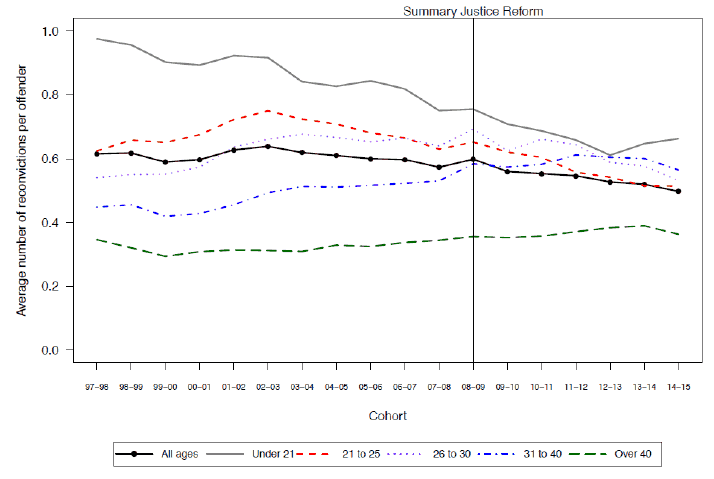
Males
Patterns of change in reconvictions (both rates and averages numbers) for males of different age groups were generally the same ( Table 4) as those for all offenders ( Table 3), with males comprising the majority of offenders (82.9% in 2014-15).
Since 2005-06 the average number of reconvictions per offender for males under 21 has decreased by 21.4% (from 0.84 in 2005-06 to 0.66 in 2014-15) and for males aged 21 to 25 by 25.0% (from 0.68 in 2005-06 to 0.51 in 2014-15). The average number of reconvictions per offender for males aged 26 to 30 has also decreased, by 18.5% since 2005-06 (from 0.65 to 0.53). The average number of reconvictions per offender has increased for the older age groups over the past 10 years. Males aged 31 to 40 have increased by 7.7% (from 0.52 in 2005-06 to 0.56 in 2014-15) and males aged over 40 years have increased by 12.5% (from 0.32 in 2005-06 to 0.36 in 2014-15). Both these groups did however see a decrease in the most recent year, decreasing by 6.7% for offenders aged 31-40 (0.60 to 0.56) and by 7.7% for those aged over 40 (0.39 to 0.36) ( Table 4 and Chart 5).
Chart 6: Average number of reconvictions per offender, females by age: 1997-98 to 2014-15 cohorts
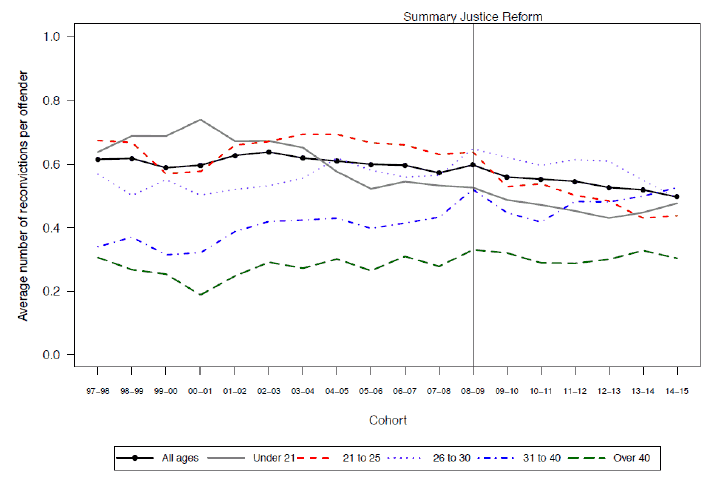
Females
Reconvictions for females under 21 and between 21 and 25 have seen some increases over the most recent couple of years. Although the reconviction rate for the under 21 age group saw a 3.6% decrease (24.8% to 23.9%) between 2013-14 and 2014-15, the average number of reconvictions per offender increased by 6.7% (0.45 to 0.48) over the same period and by 11.6% since 2012-13. The 21 to 25 age group also saw increases, with the reconviction rate increasing by 3.5% (23.0% to 23.8%) and average reconvictions per offender increasing by 2.3% (0.43 to 0.44) since 2013-14.
Over the past 10 years however, reconvictions for females aged under 21 and aged between 21 to 25 have generally decreased. The average number of reconvictions per offender decreased by 7.7% for females aged under 21 (from 0.52 in 2005-06 to 0.48 in 2014-15) and by 34.3% (from 0.67 in 2005-06 to 0.44 in 2014-15) for females age 21 to 25. Reconvictions for females aged 26 to 30 have been fluctuating over the past ten years, but they are now at their lowest level since 1997-98 with a reconviction rate of 26.5% and average reconvictions at 0.49. Reconvictions for females aged 31 to 40 have increased over the past 10 years, with average reconvictions rising 32.5% in the past ten years, from 0.40 in 2005-6 to 0.53 for the 2014-15 cohort, and the reconviction rate rose from 24.0% to 26.9% over the same period. Reconvictions for females over 40 have also increased over the past ten years, with average reconvictions increasing by 15.4%, from 0.26 in 2005-6 to 0.30 for the 2014-15 cohort. The reconviction rate also increased over the same period, by 1.6 percentage points from 16.0% to 17.6%. ( Table 5 and Chart 6).
1.3 Index crime
An "index crime" is the crime which corresponds to an "index conviction". This means it is the crime relating to the earliest conviction for non-custodial, or release date for a custodial sentences within a financial year. Please see Annex Table A1 and Annex A5 for definitions.
In general the data shows that offenders who were convicted for lower level index crimes ( i.e. shoplifting), which tend to be committed in higher volumes, are more likely to be reconvicted than those who commit more serious crimes ( i.e. sexual crimes). As has been true since 1997-98, offenders with an index crime of dishonesty, e.g. shoplifting (see Annex Table A2 for crime groupings), have the highest average number of reconvictions per offender and reconviction rate of any index crimes ( Table 6 and Chart 7). For the 2014-15 cohort, the average number of reconvictions per offender for offenders convicted of crimes of dishonesty was 0.92, and the reconviction rate was 42.5%.
By index crime: sexual crimes
Offenders in the 2014-15 cohort who had an index crime of a sexual crime had the lowest average number of reconvictions per offender (0.18) and the lowest reconviction rate (12.1%) of any index crime ( Chart 7 and Table 6). The reconviction rates and average number of reconvictions per offender for an index sexual crime are both higher in 2014-15 than they were in 2013-14, with the reconviction rate increasing by 1.8 percentage points and average reconvictions per offender increasing by 12.5%. Both measures are still considerably lower than in 2011-12, when the reconviction rate was 13.2% and the average reconvictions per offender stood at 0.27. Because these averages are based on small numbers of offenders, compared with other index crimes, caution should be taken in drawing any longer term conclusions, as small underlying numbers are sensitive to large fluctuations in percentage terms.
Other index crimes
Offenders from the 2014-15 cohort who had index crimes other than sexual crimes or crimes of dishonesty had an average number of reconvictions per offender between 0.36, for drug offences and violent crime, and 0.53, for criminal damage. The reconviction rates were between 22.3%, for violent crime, and 31.5%, for criminal damage. The average number of reconvictions per offender for all index crimes has decreased since 2013-14 with the exception of sexual crimes, as discussed above, and drug offences, which increased by 9.1% (from 0.33 to 0.36) ( Table 6 and Chart 7).
Chart 7: Average number of reconvictions per offender, by index crime: 1997-98 to 2014-15 cohorts
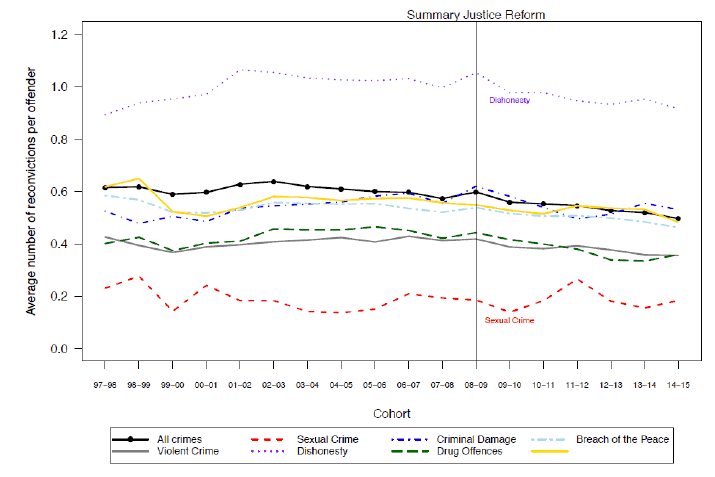
Reconviction crime by index crime
Table 7 shows the types of crimes that offenders in the 2014-15 cohort were reconvicted for, by the index crime. Overall, more offenders were reconvicted for breach of the peace than any other type of crime (10.8% of all offenders), and fewer offenders were reconvicted for a sexual crime than any other type of crime (0.3% of all offenders).
Table 7 also shows that for offenders with index crimes of violent crime, criminal damage, breach of the peace, and other crimes, are most often reconvicted for breach of the peace. Offenders with index crimes of drug offences or dishonesty, were most often reconvicted for those offences again. For those convicted of sexual crimes, the majority of those reconvicted received convictions for other crimes. It is important to note that even index crimes where the majority of offenders reconvicted were reconvicted for the same crime as the index crime, there were many offenders who were reconvicted for different crimes than their index crimes. This suggests that offenders don't necessarily specialise in a particular type of crime.
1.4 Index disposal
( Table 8)
A disposal is the sentence given for a court conviction ( i.e. custodial or community sentence), or the action taken in non-court cases ( i.e. Anti-social Behaviour Fixed Penalty Notices or Fiscal Fines). The index disposal is the sentence received for an index conviction (see Annex Table A1 and Annex A5 for definitions). If a person is convicted for more than one charge, then it is the disposal for the main crime/offence that is considered the index disposal (see Annex A4). A disposal may affect the reconviction rates, but different disposals are given for different types of offending behaviour, which are also likely to affect reconviction rates. There has been a general decline in the average number of reconvictions per offender across all types of disposals since 2004-05 ( Chart 8).
Custodial sentences
Those offenders released from a custodial sentence in the 2014-15 cohort had a higher reconviction rate and average number of reconvictions per offender than offenders given any other disposal except a DTTO. The reconviction rate for offenders released from custody in the 2014-15 cohort was 43.3%, a 0.6 percentage point decrease on the 2013-14 rate of 43.9%. The average number of reconvictions per offender has stayed the same at 0.85 between 2013-14 and 2014-15 ( Table 8 and Chart 8).
Over the last decade, there has been a decline in the average number of reconvictions per offender for those released from custodial sentences, decreasing by 17.5% from 1.03 in 2005-06 to 0.85 in 2014-15 ( Table 8, Chart 8). The long term decline in the reconviction rate for custodial sentences has been set against a sustained overall increase in the prison population during the 2000s. Since 2011-12, the prison population has been decreasing by about 2% a year. However, the relationship between patterns of reconviction and the prison population is not straightforward and one should not necessarily infer a direct causal link between the two. Trends in and drivers of the prison population are discussed in detail in the publication Prison statistics and population projections Scotland: 2013-14.
Restriction of Liberty Orders
Offenders given Restriction of Liberty Orders ( RLOs) in the 2014-15 cohort had a reconviction rate of 33.5%, the third highest rate compared to other disposals. This is 2 percentage points lower than in 2013-14. The average number of reconvictions per offender was 0.59, also the third highest, and that is 1.7% lower than in 2013-14.
Over the last decade there has been a 20.5 percentage point decrease in the reconviction rate for RLOs, and the average number of reconvictions has more than halved from 1.22 in 2005-6 to 0.59 for the most recent cohort. Because these averages are based on small numbers of offenders, compared with other index disposals, caution should be taken in drawing any longer term conclusions, as small underlying numbers are sensitive to large fluctuations in percentage terms.
Chart 8: Average number of reconvictions per offender by index disposal: 1997-98 to 2014-15 cohorts
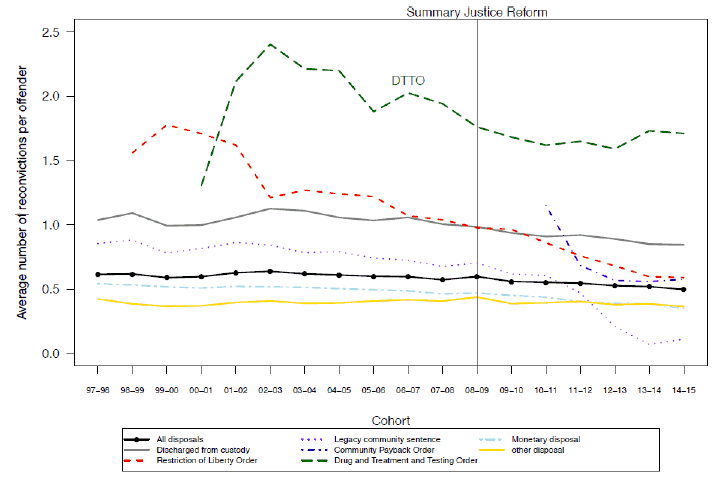
Community Payback Orders
Community Payback Orders ( CPOs) were introduced by the Criminal Justice and Licensing (Scotland) Act 2010 and came into effect from 1 February 2011. The CPO replaces provisions for Community Service Orders ( CSO), Probation Orders ( PO) and Supervised Attendance Orders ( SAO) - the "legacy orders" - for any offences committed after this date. Annex D gives a brief overview of the trends for the transitional period from 2010-11 to 2013-14.
The 10,854 offenders with an index disposal of a CPO in 2014-15 had a reconviction rate of 32.7%, which is two percentage points higher than the rate in 2013-14. This rate is 1.1 percentage points lower than the reconviction rate (33.6%) of the legacy orders in 2009-10 before CPOs were introduced. The average number of reconvictions per offender for individuals given a CPO in 2014-15 was 0.58, 3.6% higher than in 2013-14, but 6.5% lower than the figure of 0.62 for the legacy orders in 2009-10.
Drug Treatment and Testing Orders
Offenders given a Drug Treatment and Testing Order ( DTTO) have the highest average number of reconvictions per offender and the highest reconviction rate compared to the other disposals ( Table 8 and Chart 8). The number of offenders who received a DTTO in the 2014-15 cohort was 259. The average number of reconvictions per offender was 1.71 for this cohort, which represents a decrease of 1.2% on the 2013-14 value of 1.73, and the reconviction rate was 63.3% which is a 1 percentage point decrease on the 2013-14 value of 64.3%.
Over time, there has been a general decline in the average number of reconvictions per offender for offenders who are given a DTTO. In the past ten years, the average number of reconvictions per offender for DTTOs decreased by 9.0%, from 1.88 in 2005-06 to 1.71 in 2014-15. In the same period there has also been a 6.8 percentage point decline in reconviction rates, decreasing from 70.1% in 2005-6 to the current rate of 63.3%. Again, however, caution should be taken in drawing any longer term conclusions, due to the small numbers of DTTOs issued each year.
Monetary disposals
Between the 2013-14 and 2014-15 cohorts, the average number of reconvictions for monetary disposals has decreased by 10.3%, from 0.39 to 0.35. The reconviction rate also decreased, by one percentage point from 23.2% to 22.2%.
There was a continual decrease in the number of individuals who were given a monetary disposal between 2006-07 and 2012-13. In 2006-07 there were 28,500 offenders with an index monetary disposal which has since nearly halved to 14,802 in 2012-13, although the numbers have increased by just over 400 disposals over the recent two cohorts. This may in part reflect the impact of Summary Justice Reform which were designed to take less serious cases out of the court system. Between 2006-7 and 2012-13, the average number of reconvictions for offenders with an index monetary disposal fell from 0.49 to 0.39, a decrease of 20.4%.
1.5 Sentence length of custodial index conviction
( Table 9)
Offenders who were released from a custodial sentence of 3 months or less have a higher reconviction rate and average number of reconvictions per offender compared to those released from longer custodial sentences ( Table 9 and Chart 9). Offenders who commit relatively low level crimes but in high volumes are more likely to be reconvicted (see Section 1.3), and these offenders are more likely to get short custodial sentences. In contrast, longer custodial sentences are given to offenders who commit more serious crimes, but these offenders tend to commit these crimes in low volumes, and hence are less likely to be reconvicted.
Chart 9: Reconviction rates for index disposals and sentence lengths for the 2014-15 cohort 1
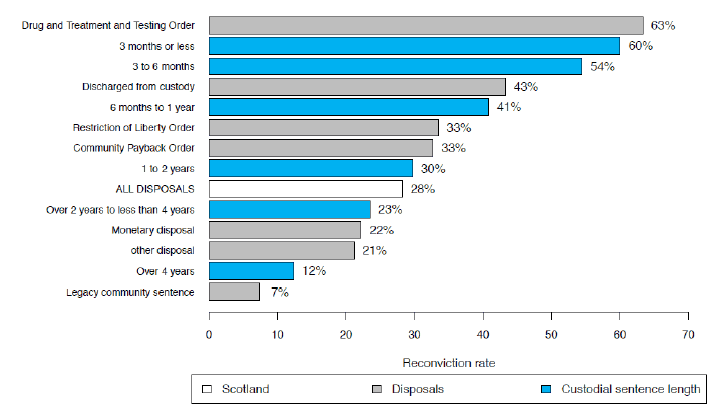
1. Chart 9 shows reconviction rates broken down by disposal type. This includes the category "disposal from custody" which shows reconviction rates for all offenders discharged from a custodial sentence in 2014-15, as well a further breakdown of this category by length of custodial sentence for comparison.
For those released from short sentences of under 3 months, the average number of reconvictions per offender was 1.25, representing a 6.0% decrease since 2013-14, and the reconviction rate was 60.0%, a decrease of 0.8 percentage points since 2013-14. On the other hand, offenders released from sentences of over 4 years had an average number of reconvictions per offender of 0.13, an increase of 0.04 percentage points, and a reconviction rate of 12.3%, an increase of 4.5 percentage points in 2014-15. Over the longer term however, reconvictions for sentences over 4 years have seen a steady decline over the past ten years. Moreover however, caution should be taken in drawing any longer term conclusions, due to the small, and declining, numbers of offenders with an index disposal of a sentence over 4 years in each cohort.
1.6 Conviction history prior to index conviction
( Table 10)
Conviction history is a strong predictor for the likelihood of reconviction, as reconviction rates increase with increasing numbers of previous reconvictions. Offenders with more than 10 previous convictions in the past ten years have the highest reconviction rates, whereas offenders with no previous convictions in the past ten years have the lowest reconviction rates. This pattern holds true even when age, sex, or disposal (all of which have an association with the likelihood of reconviction) are taken into account ( Table 10).
1.7 Two year rates
( Table 12)
Historically, reconviction rates in Scotland have been reported with a two-year follow-up period. From the 2009-10 cohort bulletin onwards, the focus has been mainly on a follow-up period of one year rather than two years as, in general, the one-year rate tracks the two year rate and has the benefit of being more timely.
Using the two-year follow up period there has been a decline in the reconviction rate and in the average number of reconvictions per offender in the past 10 years ( Table 12). Since 2005-06 the average number of reconvictions per offender has fallen by 15.0% from 1.13 to 0.96 in 2013-14 and the reconviction rate has seen a 4.9 percentage point reduction from 44.8% to 39.9% in 2013-14.
These declining trends mirror those seen for the one-year follow up period ( Table 1) but as the number of reoffenders for the two-year follow up period will also include those who reoffend over longer time periods, the associated values will typically be greater, for instance:
- In 2013-14 the two-year reconviction rate was 11.7 percentage points higher than the rate using a one-year follow on period; and
- The average reconvictions per offender are nearly half a conviction (0.46) higher for the two-year rate.
Contact
Email: Mariken Schipper
Phone: 0300 244 4000 – Central Enquiry Unit
The Scottish Government
St Andrew's House
Regent Road
Edinburgh
EH1 3DG
There is a problem
Thanks for your feedback